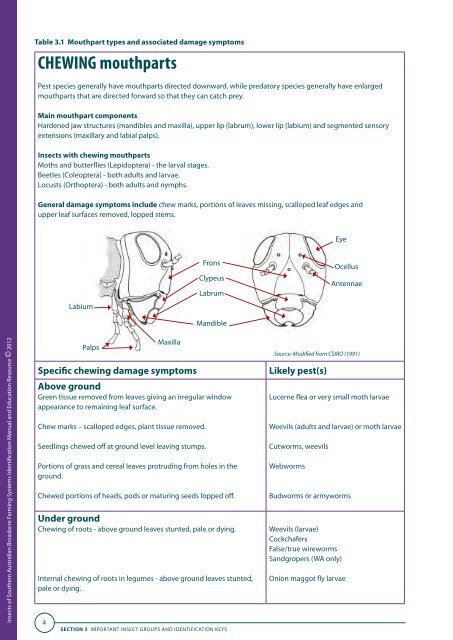Insects of Southern Australian Broadacre Farming Systems - Grains ...
Insects of Southern Australian Broadacre Farming Systems - Grains ...
Insects of Southern Australian Broadacre Farming Systems - Grains ...
You also want an ePaper? Increase the reach of your titles
YUMPU automatically turns print PDFs into web optimized ePapers that Google loves.
Table 3.1 Mouthpart types and associated damage symptoms<br />
CHEWING mouthparts<br />
Pest species generally have mouthparts directed downward, while predatory species generally have enlarged<br />
mouthparts that are directed forward so that they can catch prey.<br />
Main mouthpart components<br />
Hardened jaw structures (mandibles and maxilla), upper lip (labrum), lower lip (labium) and segmented sensory<br />
extensions (maxillary and labial palps).<br />
<strong>Insects</strong> with chewing mouthparts<br />
Moths and butterflies (Lepidoptera) - the larval stages.<br />
Beetles (Coleoptera) - both adults and larvae.<br />
Locusts (Orthoptera) - both adults and nymphs.<br />
General damage symptoms include chew marks, portions <strong>of</strong> leaves missing, scalloped leaf edges and<br />
upper leaf surfaces removed, lopped stems.<br />
Eye<br />
Labium<br />
Frons<br />
Clypeus<br />
Labrum<br />
Mandible<br />
Ocellus<br />
Antennae<br />
<strong>Insects</strong> <strong>of</strong> <strong>Southern</strong> <strong>Australian</strong> <strong>Broadacre</strong> <strong>Farming</strong> <strong>Systems</strong> Identification Manual and Education Resource © 2012<br />
Specific chewing damage symptoms<br />
Above ground<br />
Green tissue removed from leaves giving an irregular window<br />
appearance to remaining leaf surface.<br />
Chew marks – scalloped edges, plant tissue removed.<br />
Seedlings chewed <strong>of</strong>f at ground level leaving stumps.<br />
Portions <strong>of</strong> grass and cereal leaves protruding from holes in the<br />
ground.<br />
Chewed portions <strong>of</strong> heads, pods or maturing seeds lopped <strong>of</strong>f.<br />
Under ground<br />
Chewing <strong>of</strong> roots - above ground leaves stunted, pale or dying.<br />
Internal chewing <strong>of</strong> roots in legumes - above ground leaves stunted,<br />
pale or dying.<br />
4<br />
Palps<br />
Maxilla<br />
SECTION 3 IMPORTANT INSECT GROUPS AND IDENTIFICATION KEYS<br />
Source: Modified from CSIRO (1991)<br />
Likely pest(s)<br />
Lucerne flea or very small moth larvae<br />
Weevils (adults and larvae) or moth larvae<br />
Cutworms, weevils<br />
Webworms<br />
Budworms or armyworms<br />
Weevils (larvae)<br />
Cockchafers<br />
False/true wireworms<br />
Sandgropers (WA only)<br />
Onion maggot fly larvae

















